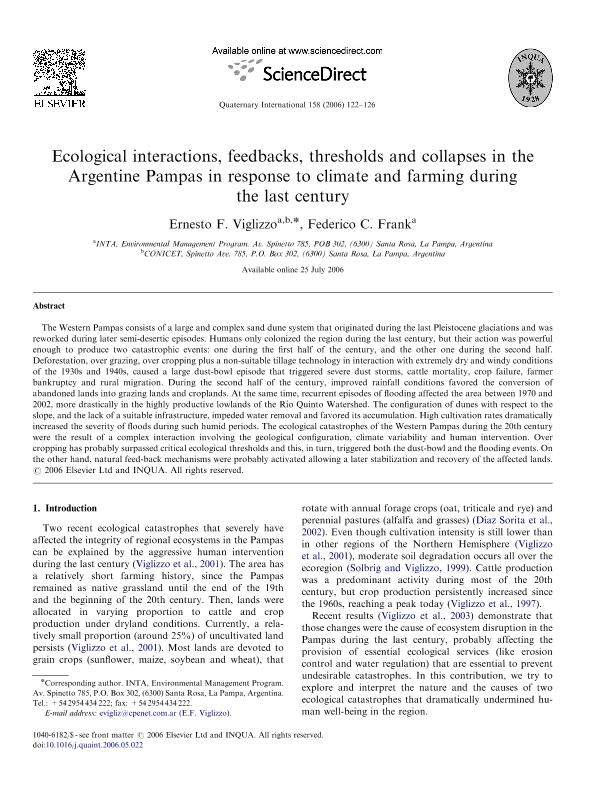Mostrar el registro sencillo del ítem
dc.contributor.author
Viglizzo, Ernesto Francisco

dc.contributor.author
Frank, Federico Carlos

dc.date.available
2019-08-20T15:51:16Z
dc.date.issued
2006-12
dc.identifier.citation
Viglizzo, Ernesto Francisco; Frank, Federico Carlos; Ecological interactions, feedbacks, thresholds and collapses in the Argentine Pampas in response to climate and farming during the last century; Pergamon-Elsevier Science Ltd; Quaternary International; 158; 1; 12-2006; 122-126
dc.identifier.issn
1040-6182
dc.identifier.uri
http://hdl.handle.net/11336/81805
dc.description.abstract
The Western Pampas consists of a large and complex sand dune system that originated during the last Pleistocene glaciations and was reworked during later semi-desertic episodes. Humans only colonized the region during the last century, but their action was powerful enough to produce two catastrophic events: one during the first half of the century, and the other one during the second half. Deforestation, over grazing, over cropping plus a non-suitable tillage technology in interaction with extremely dry and windy conditions of the 1930s and 1940s, caused a large dust-bowl episode that triggered severe dust storms, cattle mortality, crop failure, farmer bankruptcy and rural migration. During the second half of the century, improved rainfall conditions favored the conversion of abandoned lands into grazing lands and croplands. At the same time, recurrent episodes of flooding affected the area between 1970 and 2002, more drastically in the highly productive lowlands of the Río Quinto Watershed. The configuration of dunes with respect to the slope, and the lack of a suitable infrastructure, impeded water removal and favored its accumulation. High cultivation rates dramatically increased the severity of floods during such humid periods. The ecological catastrophes of the Western Pampas during the 20th century were the result of a complex interaction involving the geological configuration, climate variability and human intervention. Over cropping has probably surpassed critical ecological thresholds and this, in turn, triggered both the dust-bowl and the flooding events. On the other hand, natural feed-back mechanisms were probably activated allowing a later stabilization and recovery of the affected lands.
dc.format
application/pdf
dc.language.iso
eng
dc.publisher
Pergamon-Elsevier Science Ltd

dc.rights
info:eu-repo/semantics/openAccess
dc.rights.uri
https://creativecommons.org/licenses/by-nc-sa/2.5/ar/
dc.subject
Land Use Change
dc.subject
Non-Linear Behavior
dc.subject
Soil Erosion
dc.subject
Floods
dc.subject.classification
Ecología

dc.subject.classification
Ciencias Biológicas

dc.subject.classification
CIENCIAS NATURALES Y EXACTAS

dc.title
Ecological interactions, feedbacks, thresholds and collapses in the Argentine Pampas in response to climate and farming during the last century
dc.type
info:eu-repo/semantics/article
dc.type
info:ar-repo/semantics/artículo
dc.type
info:eu-repo/semantics/publishedVersion
dc.date.updated
2019-08-15T16:22:50Z
dc.journal.volume
158
dc.journal.number
1
dc.journal.pagination
122-126
dc.journal.pais
Países Bajos

dc.journal.ciudad
Amsterdam
dc.description.fil
Fil: Viglizzo, Ernesto Francisco. Consejo Nacional de Investigaciones Científicas y Técnicas; Argentina. Instituto Nacional de Tecnología Agropecuaria; Argentina
dc.description.fil
Fil: Frank, Federico Carlos. Instituto Nacional de Tecnología Agropecuaria; Argentina
dc.journal.title
Quaternary International

dc.relation.alternativeid
info:eu-repo/semantics/altIdentifier/url/https://www.sciencedirect.com/science/article/pii/S1040618206001595
dc.relation.alternativeid
info:eu-repo/semantics/altIdentifier/doi/https://doi.org/10.1016/j.quaint.2006.05.022
Archivos asociados
